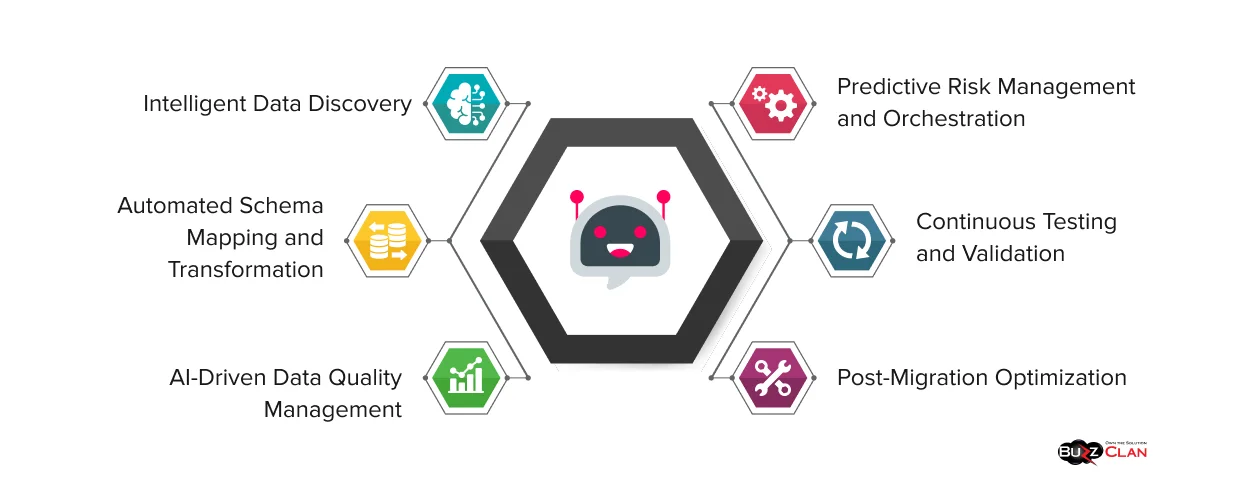The Role of AI in a Successful Data Migration Framework
Manoj Kumar
Nov 4, 2025
Every enterprise has faced it — the migration that didn’t go as planned.
Despite months of preparation, projects run over time, costs escalate, and data quality begins to falter.
These challenges are more common than many leaders admit. In fact, research shows that nearly 83% of data migration projects fail.
Traditional approaches often rely heavily on manual processes and reactive problem-solving, which makes managing complexity even harder. Data mapping, validation, and transformation become time-consuming, error-prone, and costly.
AI-powered frameworks change this dynamic. By introducing intelligent automation, pattern recognition, and predictive validation, they allow teams to address issues proactively rather than reactively. Migration becomes more controlled, efficient, and accurate, thereby reducing risk and enabling organizations to focus on achieving business outcomes rather than addressing technical issues.
In this article, we’ll explore how AI reshapes data migration strategy — from planning to validation — and how organizations can build a framework that delivers consistency, compliance, and confidence at scale.
Transform migration complexity into a competitive advantage.
Explore how modern data stack architectures integrate seamlessly with AI-powered frameworks to deliver enterprise-grade results.
The Challenges of Traditional Data Migration
Traditional data migration projects often face several recurring challenges that increase risk and complexity:
- Human errors: Manual mapping and data checking often lead to mistakes. Errors can cause mismatches or corrupt data, resulting in incorrect reports or disrupted business processes.
- Downtime and disruption: Migrating data often requires systems to be offline for some time, which impacts business operations and frustrates users.
- High costs: Manual processes and repeated error corrections consume time and resources, driving up migration expenses and diverting attention from strategic initiatives.
- Complex environments: Many organizations operate across multiple databases, cloud platforms, and applications. Traditional tools are not always equipped to handle this complexity, leading to incomplete or slow migrations.
- Scaling problems: As data volumes grow, traditional migration methods struggle to keep up, creating bottlenecks and increasing the risk of delays or data inconsistencies that affect business operations.
Take the Guesswork Out of Data Migration
With BuzzClan’s AI-first methodology, you can streamline complex migrations, avoid costly errors, and gain confidence in your data every step of the way.
How AI Transforms Data Migration
AI is transforming data migration by bringing intelligence, automation, and precision to traditionally complex and error-prone processes. Unlike manual, rule-based methods, AI leverages machine learning and advanced analytics to optimize every migration phase. Take a look at how:
- Automated discovery and dynamic mapping: AI uses pattern recognition and semantic analysis to understand not only data structures but also business context.
For example, it can identify that "customer_id" in one system matches "client_ref" in another, reducing mapping errors that often occur in manual approaches.
- Adaptive schema reconciliation: AI can dynamically detect schema evolution and discrepancies during migration, automatically transforming data types, handling nested or hierarchical structures, and resolving conflicts such as nulls or duplicates without manual intervention.
- Adapting to different schemas: Each system may store data differently, and AI can automatically adjust for these differences by converting data types, handling missing values, and merging duplicate records. This flexibility ensures the new system receives clean and consistent data.
- Intelligent data cleaning: AI continuously learns normal data patterns and spots anomalies like wrong entries or duplicates early in the process. This proactive cleaning prevents problems from compounding after migration, saving valuable time and cost on fixes.
- Predictive risk analysis: By examining past migration logs and real-time system behavior, AI predicts possible failures, such as downtime or data inconsistency, before they occur. This foresight allows migration teams to act proactively, minimizing disruptions and costly rollbacks.
- Ongoing validation with explainability: AI not only checks data integrity but also creates clear audit trails explaining what changes were made and why. This transparency is vital for industries that require strict compliance, like healthcare and finance.
- Optimization post-migration: After the move, AI monitors system performance and automatically tunes database configurations to maximize speed and efficiency, enabling businesses to derive full value from their new data environment.
According to industry research, AI can reduce manual effort in data migration projects by up to 80%, accelerate timelines by 30–40%, and enhance data accuracy and regulatory compliance. This positions AI as a critical strategic partner in managing complex modern migrations.
Key Components of an AI-Powered Data Migration Framework

An effective AI-powered data migration framework combines multiple advanced elements:
- Intelligent Data Discovery: AI continuously scans source systems to create a dynamic catalogue of data assets, including metadata, data quality metrics, and business context. This helps uncover hidden relationships and critical dependencies that manual discovery often misses, reducing surprises during migration.
- Automated Schema Mapping and Transformation: Machine learning algorithms align source and target schemas dynamically. Unlike static mappings, AI handles evolving data structures and complex transformations—such as converting between nested JSON and relational formats—without extensive manual coding.
- AI-Driven Data Quality Management: Embedded anomaly detection, deduplication, and correction mechanisms help ensure migrated data maintains integrity. Machine learning models analyze historical error patterns to proactively identify potential quality issues, enabling resolution before cutover with minimal manual intervention.
- Predictive Risk Management and Orchestration: By analyzing operational logs and historical migration data, AI predicts bottlenecks, potential downtime, and data loss risks. It automatically orchestrates remediation actions, reducing manual oversight and accelerating issue resolution.
- Continuous Testing and Validation: AI-assisted test automation validates schema, volume, and record-level accuracy across the migrated dataset, generating detailed, transparent reports. Explainable AI highlights and explains flagged anomalies or transformation decisions, supporting compliance audits and reducing manual verification effort.
- Post-Migration Optimization: After migration, AI monitors system performance, query efficiency, and resource utilization, suggesting or applying optimizations such as index tuning or partitioning to ensure peak performance in production.
Real-World Use Cases of AI in Data Migration
Several enterprise-grade projects have demonstrated the benefits of AI-powered data migration, delivering measurable results across industries:
- Enterprise Asset Management Company Transforms Database Infrastructure: BuzzClan automated database migration and performance optimization for a leading enterprise asset management company, managing over 200 SQL and Oracle databases. Through strategic database migration automation, the project achieved a 53% cost reduction, 71% operational efficiency gain, and 100% uptime. The AI-powered framework eliminated manual processes and implemented proactive monitoring, enabling the client to focus on core business innovation.
- Healthcare System Conquers Data Deduplication Challenge: A large healthcare organization faced a complex migration of over 25 terabytes across four databases, complicated by legacy Lotus Notes files that had been processed in HTML format. Lighthouse's proprietary AI technology created unique hash values that enabled seamless deduplication between old HTML files and new EML formats. The entire migration was completed in just 5 months while keeping all systems active for ongoing operations.
- Wearables Technology Leader Achieves 40% Speed Boost: A leading wearables manufacturer partnered with WNS to migrate vast quantities of supply chain and operational data from legacy systems to cloud platforms. Using AI-enabled migration accelerators and automated schema mapping, the project achieved impressive results: a 40% reduction in migration timelines, a 30% faster time-to-market for new products, and a 30% savings in managed services costs.
- Retail Giant Accelerates ERP Migration with GenAI: A retail conglomerate leveraged illumex's GenAI technology to migrate from SAP ECC to S/4 HANA, handling over 115,000 tables and 1.5 million data columns. The AI-powered documentation and mapping solution compressed what could have been a two-year manual review process into just one week, while providing automated translation of complex technical terms for improved stakeholder engagement.
Best Practices for Incorporating AI into a Data Migration Framework
These essential practices ensure smooth deployment and maximize the benefits of intelligent migration frameworks:
- Start Small with Pilot Projects: Begin AI implementation with smaller, less critical datasets to validate your approach and build confidence. Choose a pilot project that represents your typical migration challenges but has a manageable scope and clear success metrics. This allows teams to learn AI tool capabilities, identify potential issues, and refine processes before scaling to larger, mission-critical migrations.
- Maintain Strict Compliance and Governance: Establish comprehensive data governance frameworks before initiating AI-powered migrations. This includes implementing robust identity management, access controls, and audit trails specifically designed for AI-driven processes. Ensure your AI tools can generate detailed compliance reports and maintain data lineage throughout the entire migration process.
- Collaborate with Subject Matter Experts: Form cross-functional teams that combine AI specialists with domain experts who understand your data landscape. Business stakeholders should actively participate in defining migration objectives and validating results, while technical teams focus on AI implementation. This collaboration ensures AI tools are properly configured to understand business context and data relationships. Regular communication between teams prevents misalignment and helps identify issues early on.
- Implement Comprehensive Testing and Validation: Develop robust testing protocols for AI-driven migrations, including unit testing of AI models, integration testing with existing systems, and volume testing using representative datasets. Automate validation processes to verify data completeness, accuracy, and correctness of transformations.
- Monitor Continuously Post-Migration: Deploy real-time monitoring systems to track data quality, system performance, and user adoption post-migration. AI-powered monitoring can detect anomalies, performance degradation, or emerging data quality issues. Establish feedback loops to capture user experiences and system behavior, enabling rapid issue resolution.
How BuzzClan Can Help Transform Your Data Migration
BuzzClan combines deep industry expertise with AI-powered tools to make data migration projects faster, safer, and more reliable. Here’s how we help organizations tackle common migration challenges:
- AI-Powered Migration Automation: Our AI-driven platform automates key migration tasks—from data discovery and mapping to transformation and validation—reducing manual errors and accelerating timelines. Intelligent anomaly detection and pattern recognition ensure data integrity throughout the process.
- Comprehensive Data Engineering: We manage seamless transfers across relational databases, NoSQL systems, cloud platforms, and legacy environments. Our approach handles complex data landscapes efficiently while maintaining performance, consistency, and security at every stage.
- Enterprise-Grade Security and Compliance: Data safety is non-negotiable. BuzzClan implements real-time monitoring, automated threat detection, and incident response to safeguard your data during migration. Compliance with GDPR, HIPAA, and SOC-2 standards ensures your migration meets regulatory requirements.
- Knowledge Transfer and Expert Guidance: Beyond execution, we equip your team to manage and optimize your new data environment. Through customized training, process documentation, and ongoing consultation, we help your organization leverage AI-driven workflows independently and confidently.
Experience the same transformative results our enterprise clients have achieved—seamless migrations with 100% uptime and measurable ROI.
Schedule your consultation with BuzzClan's AI migration experts and discover how intelligent automation can accelerate your data transformation journey.<
Conclusion
Data migration no longer has to be the costly, high-risk bottleneck it once was. By adopting AI-driven frameworks, enterprises can reduce timelines, minimize errors, and gain confidence in the integrity of their data. These frameworks enable proactive validation, intelligent anomaly detection, and automated transformation processes, turning migration from a disruptive task into a predictable, value-generating operation. Organizations that recognize and act on this shift today are better positioned to achieve reliable, efficient migrations tomorrow.
Ready to Experience Seamless, Secure Data Migration? Connect With Us!
BuzzClan’s AI-powered framework helps modern enterprises move past outdated migration approaches and achieve streamlined, secure transitions. If you’re interested in learning how intelligent automation can transform your next migration project, our experts are here to guide you.
FAQs

Get In Touch